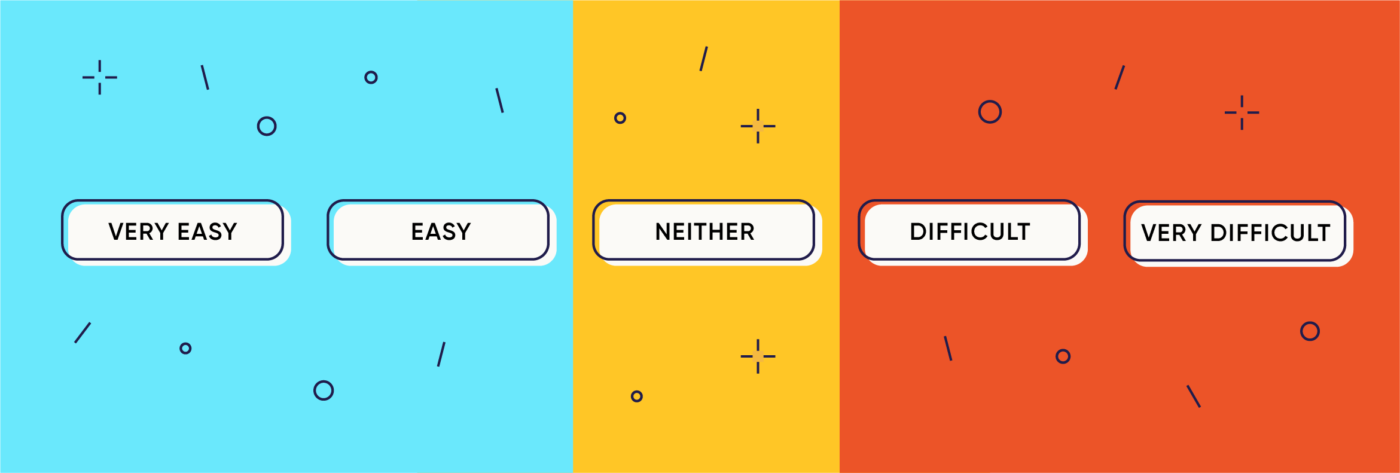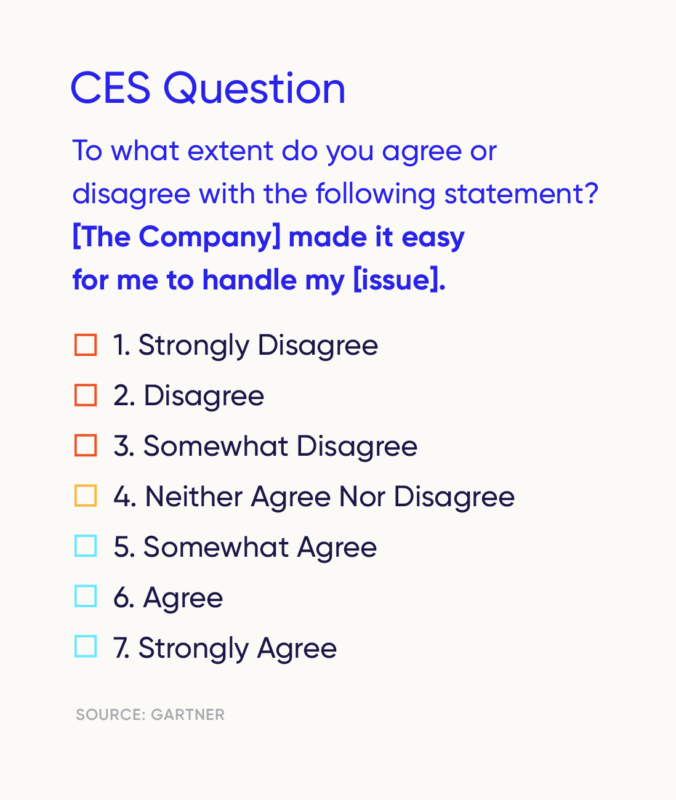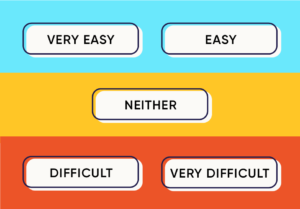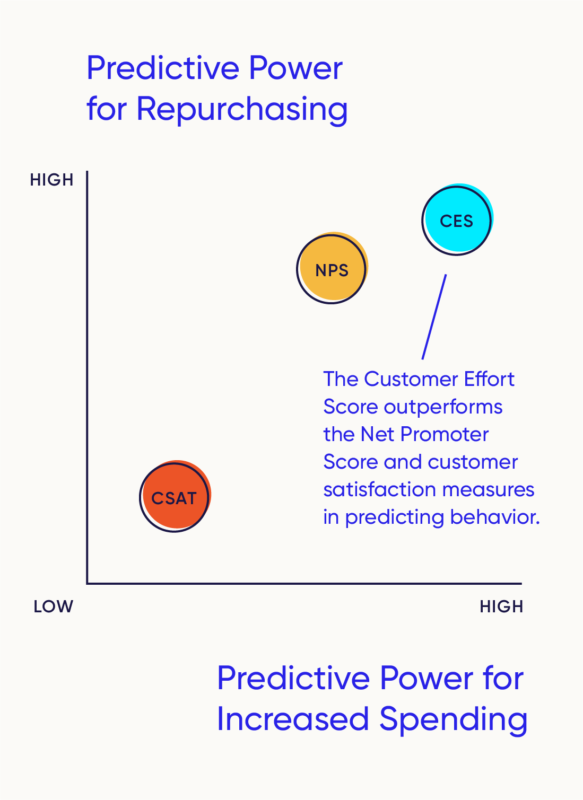
What Is Customer Effort Score?
The Customer Effort Score is a customer service metric that measures how much effort a customer has to exert during an problem solving interaction with a business. Customers rate the ease of their user experience on a scale of “very difficult” to “very easy” in a quick, one-question survey. This customer feedback survey helps organizations evaluate their customer experience initiatives.
The Customer Effort Score, introduced by CEB Global (now Gartner) in 2010, supports other CX metrics obtained from customer satisfaction (CSAT, popularized in the 1980s) and Net Promoter Score (NPS, introduced in 2003). By asking users about their experience through the lens of effort, a business can understand just how easy it is for a customer to make a purchase or troubleshoot a problem.
A Customer Effort Scores provides insight into the “why” behind low customer satisfaction and Net Promoter Score ratings, plus the barriers that need to be removed in order to drive loyalty and happiness. All three metrics, when used together, can build a more complete and beneficial view of customer sentiment and customer loyalty.

Why is Customer Effort Score Important?
Customer Effort Score is increasingly important within CX organizations for three reasons:
- Customer experience measurement and KPIs are top priorities for CX leaders. Many leaders struggle to differentiate the real CX issues from the noise and capture actionable insights from their current CX metrics. What makes the Customer Effort Score formula different is that the measure is a mix of how customers feel and what they have to do during an interaction. In practice, Customer Effort Score measures how much effort customers have to exert (again based on how they feel and what they do) to resolve an issue, make a purchase, or get a question answered, for example.
- Customer loyalty. According to Gartner, customer effort is the strongest driver of consumer loyalty – or disloyalty. Their research found that reducing customer effort has a proven relationship to higher-level goals in an organization, such as maintaining loyalty and minimizing service costs. Additionally, customers with a high-effort service experience are much more likely to stop using the company altogether and spread negative word of mouth. Gartner’s 2020 Loyalty Through Customer Service and Support Survey once again reported 96% of customers with a high-effort service interaction are likely to switch to another provider, compared with only 9% who experience low-effort interactions.
By measuring the Customer Effort Score, CX leaders can actively manage user experience in order to influence, with the intent to reduce, customers’ perceptions of effort. - Lastly, customer effort was found to be a strong predictor of a customer’s willingness to recommend a company’s products or services to others. Customer willingness or advocacy, customer behavior measured by a Net Promoter Score (NPS), is used as a proxy for gauging the overall health of a customer relationship. According to Gartner’s Customer Effort Survey, NPS is 65 points higher for top-performing low-effort companies than for high-effort companies.
Using Customer Effort Scores in combination with NPS scores allows CXOs and CX leaders to move away from a “squeaky wheel” strategy, which primarily focuses proactive outreach on customers who actively complain, and move towards an inclusive approach recognizing all who reported high-effort interactions and are likely dissatisfied.
How is a Customer Effort Score Calculated?
Customer Effort Score is measured by asking a single question in a survey and scoring the response on a scale from 1 to 7 or 1 to 5, with 1 representing the highest level of disagreement with the statement. The survey question is designed to measure the ease of customer interaction and resolution during a request and is written in easy-to-understand language.
In this example, a question uses a Customer Effort Score formula with a 5-point scale to determine the level of effort or ease of customer issue resolution. The 5-point scale uses extreme positive (very easy), positive (easy), neutral (neither), negative (difficult), and extreme negative (very difficult) answer options to gather the Customer Effort Score data. Customers choose the sentiment that best represents their experience and effort in doing business with the company in that particular interaction.

Customer Effort Score is calculated by the percentage of customers that indicate a positive experience. In Gartner’s CES Survey Question example, which uses a 7-point scale, the Customer Effort Score calculation would include those who indicate they at least “somewhat agree” (those who give a 5 or above) that the company made it easy to resolve their issue.
To calculate the Customer Effort Score:
- First, determine the percentage of positive (i.e., very easy and easy) and negative (i.e., very difficult and difficult) responses in the Customer Effort Score survey.
- Second, subtract the negative response percentage from the positive response percentage.

In practice, a Customer Effort Score survey question should be implemented after every customer transaction or interaction. A compelling use case for this data is a customer service team and management can use Customer Effort Score , along with operational metrics such as repeat calls, transfers, and channel switching, to uncover high-effort pain points in customer interactions. The Customer Effort Score survey data can highlight opportunities to build loyalty and drive happiness. For example, CXOs and CX leaders can identify where improvements can be made to move customers out of a negative experience or neutral territory into a positive experience.
What is a Good Customer Effort Score?
In general, a Customer Effort Score percentage under 70% warrants an evaluation and a deeper look into what could be causing negative customer feedback on the customer effort score results. Customer Effort Score success looks different for every company and support team. As a guidepost, Gartner released the overall benchmarks of effort, showing Customer Effort Score percentages below 70% as areas for improvement and above 90% as strong.
The best way to determine what a good Customer Effort Score is for your organization and start measuring progress is to compare your Customer Effort Score calculation against your scores over time, by quarter or semi-annually. An increase of at least 10% is an indication of progress in the right direction. Conversely, a significant decrease in Customer Effort Score is an indication of negative customer experiences or unmet customer expectations.
As a best practice, focus on what drives your score rather than the number in the Customer Effort Score results. One of the pros and cons of Customer Effort Score results is the data comes from a survey that is easy to deploy and track over time; however, the score doesn’t always provide the full picture. Consider this scenario: Your customer may have a great relationship with your company but, in one instance, had a bad experience that resulted in a low Customer Effort Score score. An evaluation based on a scorw alone could segment customers in this scenario as unlikely loyal customers. But that might not be the case at all.
What NPS and CSAT measure are important in explaining how to interpret customer effort score results.
- Customer Effort Score vs NPS – Customer Effort Score is measured in a single touchpoint, and NPS is measured by the customer’s experience as a whole, including the product attributes, price, brand, and customer service altogether. Customer Effort Score and NPS together can build a more complete view of customer sentiment.
- Customer Effort Score vs CSAT – A Customer Satisfaction Score is a transactional metric primarily used to measure an in-the-moment reaction to a specific interaction, product, or event. Like Customer Effort Score, it is limited when it comes to measuring a customer’s ongoing relationship with a company or loyalty, but provides greater insight into the customer’s service experience.
In summary, deploy Customer Effort Score surveys via email, chat, or SMS immediately after customer interactions or at specific touchpoints like a purchase or exchanges with customer service reps to understand how easy it was for the customer to engage with your business. Then use the results in combination with Net Promoter Score (NPS) and/or Customer Satisfaction (CSAT) survey results to build a more complete view of the customer experience and how well you are managing expectations and making customer interactions easy.
How Can I Apply the Customer Effort Score Metric?
Companies can measure customer effort across all of the steps and actions a customer has to take during a service experience. These interactions include wait time, transfers, repeating information, repeated contacts, and channel switching. In fact, many companies found high-effort indicators in scenarios where customers switch channels to get their problem resolved, receive repeating information, or get transferred to a different support team agent. As a result, these companies prioritized the use of customer effort measurement in the customer service function. However, there is a broader use of the measure for management to consider across customer-facing functions, like sales, marketing, supply chain, software, and IT.
Let’s consider sales, whether it be a product or service. Today’s NOW Customer has always-on access to better quality information and buying options than ever before. While more knowledge is more power, the information overload can make customers feel easily overwhelmed during the purchase process. Overwhelm coupled with a high-effort buying process doesn’t end well. In fact, Gartner’s research found progressive sales organizations that make it easy for customers to buy are 62% more likely to close a high-quality sale. Takeaway: Increase the likelihood of winning a high-quality purchase by applying the Customer Effort Score metric to identify high-effort interactions along the buyer journey and use the Customer Effort Score survey insights to optimize the purchase process and make a sale easier.
Next, let’s explore how to apply Customer Effort Score in marketing. As we’ve covered, effort measurement captures customer perspective at the point of the service, such as a product purchase. A customer’s effort, more specifically their perception of effort, is influenced by decisions further upstream, such as an impression from a marketing campaign. And while there are no official market research figures published for 2021, the average person is now estimated to encounter between 6,000 to 10,000 ads every single day! Leading brands realize the volume of marketing messages and available choices is overwhelming customers and harming brand loyalty. Instead of fighting for more attention, leading brands focus on making it easy for customers to choose their brand with simplified, personalized, and targeted messaging that requires less thinking during the decision-making process. Takeaway: CX leaders who implement Customer Effort Score measurement need to consider all stages of the customer journey, including pre-purchase phases. They should seek support from other functions, such as marketing, to enhance the overall customer experience as a competitive advantage.
Measuring customer effort across all touchpoints in the customer journey enables CX leaders to identify high-effort areas and actions to optimize the customer experience and better communicate internally with cross-functional partners to progress forward.

How Can I Improve My Customer Effort Score Score?
We’ve covered what a Customer Effort Score is, why it is important, where Customer Effort Score surveys can be applied, and how it can provide actionable insight into customer service satisfaction and loyalty. Now we can move on to some common ways to improve a Customer Effort Score. The ultimate goal is to improve how customers feel about the level of service received and what they have to do during an interaction with your company.
Below are ways to improve your Customer Effort Score Score:
- Prioritize customer tasks and develop action plans. Rank your customer interactions (tasks), measured via a Customer Effort Score survey, from high- to low-effort. Then develop well-defined action plans and templates to address the highest-effort tasks and design experiences that reduce customer effort and provide additional customer support.
- Develop frontline employees and hold them accountable for customer-centric behaviors. How a customer feels about an experience has a lot to do with how frontline employees engage them and meet their needs. Businesses should develop their frontline employees’ soft skills and competencies, offer employee engagement programs focused on CX, and hold them accountable for their behaviors.
- Offer multiple channels for contact or feedback. Be sure your business meets customers on all channels, both online and offline, so that they can choose the mode of communication they prefer. Popular channels include email, web chat, in-person support centers, and call centers.
- Provide self-service tools. Make it easy to find answers to frequently asked or common questions. Consumers prefer low-effort ways to quickly find information, satisfy their needs, and solve issues themselves instead of contacting customer service reps. A robust help section and support articles accessible through site search is a best practice.
- Minimize wait or hold times. Being placed on hold is a frustrating experience, especially when NOW Customers want their issues resolved quickly. They don’t want to wait to speak to a live representative on the phone or a chat. If your business experiences high volume, consider a partner like Simplr to augment your team or use a callback system.
- Check in with the customer and solicit feedback. Customer service satisfaction is critically important. The Customer Effort Score question is a quick way to capture how customers feel about the user experience. Use Customer Effort Score surveys to gauge ways in which you need to improve your products or customer service program.. both on the internet and in person.
In closing, Customer Effort Score is an important metric because high-effort experiences negatively impact customer loyalty and lead to a higher total cost to resolve service requests.
By measuring effort through a Customer Effort Score survey, CX leaders can identify at-risk customers, proactively reach out to them, and remove obstacles for the customer to reduce customer service costs and attrition rates. CX leaders can also use this survey data in combination with NPS and CSAT data to reduce effort within the organization and across the various touchpoints in the customer journey, thus empowering cross-functional collaboration to improve customer experience, increase loyalty, and support revenue growth.